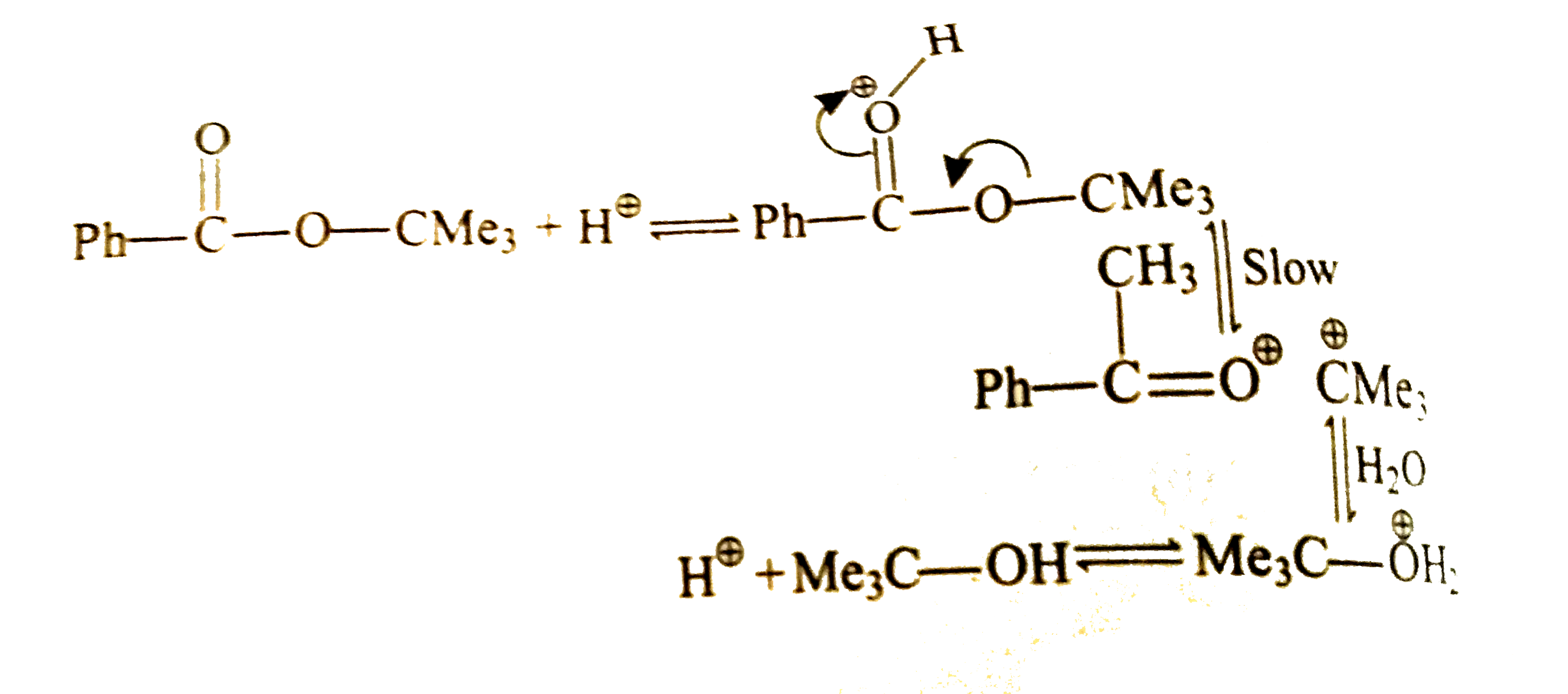Products of the above reaction contain
Both (a) and (b)
The correct Answer is:D
To solve the given reaction, we need to analyze the reactants and the conditions under which the reaction takes place. The reaction involves a compound with a carbonyl group (C=O) and an ether group (–O–C2H5) in the presence of sodium hydroxide (NaOH) and water (H2O).
1. Identify the Reactant Structure:
The given compound is CH3-CH2-C(=O)-O-C2H5. This structure consists of a carbon chain (ethyl group) attached to a carbonyl group (C=O) and an ether group (–O–C2H5).
2. Nucleophilic Attack by Hydroxide Ion:
In the presence of NaOH, the hydroxide ion (OH-) acts as a nucleophile and attacks the carbonyl carbon (C=O). This results in the formation of a tetrahedral intermediate.
3. Formation of Tetrahedral Intermediate:
The attack of the hydroxide ion leads to the formation of a tetrahedral intermediate where the carbonyl oxygen becomes negatively charged (alkoxide ion). The structure now looks like:
CH3-CH2-C(OH)(O-C2H5).
4. Proton Transfer:
In the next step, there is a proton transfer (H+ transfer) from the hydroxyl group (OH) to the ether oxygen (O-C2H5). This results in the formation of a hydroxyl group and the regeneration of the carbonyl group.
5. Elimination of Ethanol:
The tetrahedral intermediate collapses, leading to the elimination of ethanol (C2H5OH) as a leaving group. The product formed is:
CH3-CH2-C(=O)-OH.
6. Final Product:
The final product of this reaction is a carboxylic acid (specifically, butanoic acid) and an alkoxide ion (which is the result of the ether group losing a proton).
Final Products:
The products of the reaction are:
- Butanoic acid (CH3-CH2-C(=O)-OH)
- Ethoxide ion (C2H5O-)
Summary of Products:
The products of the above reaction contain:
1. Butanoic acid (CH3-CH2-C(=O)-OH)
2. Ethoxide ion (C2H5O-)
The given compound is CH3-CH2-C(=O)-O-C2H5. This structure consists of a carbon chain (ethyl group) attached to a carbonyl group (C=O) and an ether group (–O–C2H5).
In the presence of NaOH, the hydroxide ion (OH-) acts as a nucleophile and attacks the carbonyl carbon (C=O). This results in the formation of a tetrahedral intermediate.
The attack of the hydroxide ion leads to the formation of a tetrahedral intermediate where the carbonyl oxygen becomes negatively charged (alkoxide ion). The structure now looks like:
CH3-CH2-C(OH)(O-C2H5).
In the next step, there is a proton transfer (H+ transfer) from the hydroxyl group (OH) to the ether oxygen (O-C2H5). This results in the formation of a hydroxyl group and the regeneration of the carbonyl group.
The tetrahedral intermediate collapses, leading to the elimination of ethanol (C2H5OH) as a leaving group. The product formed is:
CH3-CH2-C(=O)-OH.
The final product of this reaction is a carboxylic acid (specifically, butanoic acid) and an alkoxide ion (which is the result of the ether group losing a proton).
The products of the reaction are:
- Butanoic acid (CH3-CH2-C(=O)-OH)
- Ethoxide ion (C2H5O-)
The products of the above reaction contain:
1. Butanoic acid (CH3-CH2-C(=O)-OH)
2. Ethoxide ion (C2H5O-)
Topper's Solved these Questions
- ALDEHYDES AND KETONES BOOK - ERRORLESS CHAPTER - ALDEHYDES AND KETONES EXERCISE - JEE Section Only one choice correct answer
39 Videos
- ALDEHYDES AND KETONES BOOK - ERRORLESS CHAPTER - ALDEHYDES AND KETONES EXERCISE - JEE Section More than one choice correct answer
12 Videos
- ALDEHYDES AND KETONES BOOK - ERRORLESS CHAPTER - ALDEHYDES AND KETONES EXERCISE - Ordinary Thinking (Objective Questions) Properties
207 Videos
- ALCOHOL, PHENOL AND ETHERBOOK - ERRORLESS CHAPTER - ALCOHOL, PHENOL AND ETHEREXERCISE - JEE SECTION (JEE Advanced 2018) More than one choice correct answer
1 Videos
- ANALYTICAL CHEMISTRYBOOK - ERRORLESS CHAPTER - ANALYTICAL CHEMISTRYEXERCISE - JEE Section (Only One Choice Answer)
36 Videos
Similar Questions
Knowledge Check
CH3−CH2−O∣∣C−OC2H5Na∗OH−−−→H2O∗ Products of the above reaction contain
ACH3CH2−O∣∣C−∗C−BCH3CH2−.∗C∣∣C−O−CCH3CH2−∗C−HDboth (a) and (b)CH3CH2−O∣∣C−OC2H5Na∗OH−−−→H2O∗
Products of the above reaction containACH3CH2−O∣∣C−∗O−BCH3CH2−O∗∣∣C−CCH3CH2−∗O−HDboth a and b
CH3−O||C−OCMe3H218O−−−→H2SO4 Products:ACH3−18O||C−OH+Me3C−OHBCH3−O||C−OH+Me3C−18OHCCH3−O||C−18OH+Me3C−OHDCH3−O||C−OH+Me3C−OH
H−O∣∣C−O∣∣C−HCH3MgBr(excess)−−−−−−−−−−−→H⊕3O Product :
View SolutionCH3CH2−O∣∣C−O−C2H2(i)DIBAL.H(1eq)−−−−−−−−−−−−→(ii)H3O+A+B A and B are respectively.
View SolutionConsider the following reactions
I.
II. CH3CH2BrKCN−−→H+3O−−→
III. CH3CH2O∣∣COC2H5CH3MgBr(2mol)−−−−−−−−−−→H+3O
Propanoic acid is the final product in
View SolutionThe final product (III) obtained in the reaction sequence.
CH3=O∣∣C−CH2−O∣∣C−OC2H5(i)Na−−−−−−−−−−−−→(ii)C6H5CH2BrIH5O+−−−→IIheat−−−−−−→−CO2III
Product I is :-
View SolutionC2H5O−O∣∣C−OC2H52MeMgBr−−−−−→(A). The product (A) formed can:
View Solution
